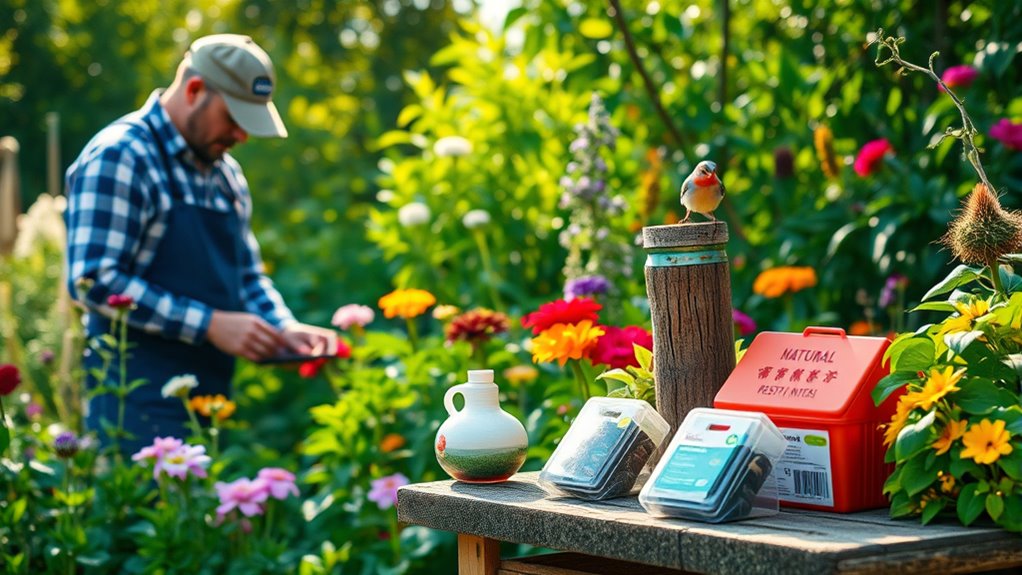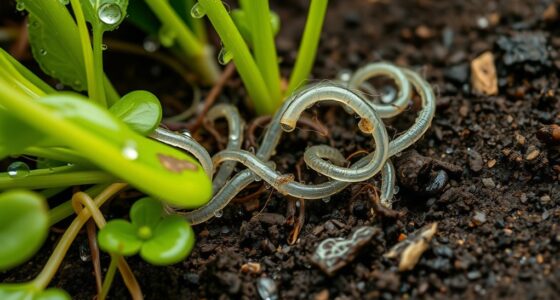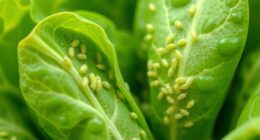Integrated Pest Management (IPM) is a sustainable approach that helps you control pests by combining different strategies. It focuses on understanding your garden’s natural ecosystem and using methods like encouraging beneficial insects, regular pest monitoring, and physical barriers. Chemical controls are used only as a last resort. By prioritizing prevention and targeted actions, IPM helps keep your garden healthy and environmentally friendly. If you want to explore effective ways to manage pests naturally, you’re in the right place.
Key Takeaways
- IPM combines multiple pest control methods to manage pests sustainably, minimizing chemical use and protecting the environment.
- It emphasizes monitoring pests regularly to detect issues early and determine if intervention is necessary.
- Biological controls, like beneficial insects, are prioritized to naturally regulate pest populations.
- Preventive practices such as habitat diversity and physical barriers are central to IPM strategies.
- Chemical controls are used only as a last resort, focusing on targeted, least invasive solutions for garden health.

Have you ever wondered how to control pests effectively without harming the environment? That’s where integrated pest management, or IPM, comes into play. IPM is a smart, sustainable approach that combines different strategies to keep pests at bay while minimizing the use of chemicals. It’s not just about spraying pesticides; it’s about understanding your garden’s ecosystem and working with it to create a healthy balance. One of the core principles of IPM is biological control, which involves introducing or encouraging natural predators like ladybugs, lacewings, or parasitic wasps to keep pest populations in check. This method leverages nature’s own pest control agents, reducing your reliance on chemical treatments that can harm beneficial insects, pollinators, and the environment. Additionally, understanding the role of pest monitoring can help gardeners identify when natural or minimal interventions are sufficient. Another essential aspect of IPM is pest monitoring. Before taking any action, you need to regularly inspect your plants for signs of pests or damage. Pest monitoring helps you identify the problem early and determine whether control measures are necessary. It also allows you to assess the severity of the infestation and choose the most appropriate response. By keeping a close eye on your garden, you can avoid unnecessary treatments, saving time, money, and reducing the risk of resistance developing among pests. Monitoring tools such as sticky traps, visual inspections, and even smartphone apps can make this task easier and more accurate. Once you’ve identified the pests, the goal is to use the least invasive, most targeted method to manage them. That might mean enhancing habitat diversity to support beneficial insects, applying organic pesticides if needed, or using physical barriers like row covers. Chemical controls are always considered a last resort in IPM, used only when other measures fail and after careful evaluation. The emphasis remains on prevention and early intervention, which are key to maintaining a healthy, productive garden.
Frequently Asked Questions
How Does IPM Compare to Traditional Pest Control Methods?
Compared to traditional pest control methods, IPM reduces your reliance on chemicals and minimizes pesticide overuse. You focus on monitoring pest levels, using targeted methods, and employing natural controls first. This approach helps protect your garden’s health, the environment, and prevents pests from developing resistance. Unlike routine pesticide sprays, IPM promotes sustainable practices that keep pests in check while keeping your garden safe and thriving.
Are There Specific Pests That IPM Is Most Effective Against?
You might think IPM targets only big pests, but it’s actually versatile for many. It excels at pest targeting, especially for insects like aphids, beetles, and caterpillars, helping protect your crops naturally. Unlike traditional methods, IPM promotes crop protection with minimal chemical use. This approach is most effective against pests that threaten plant health and yield, making it an essential tool for sustainable gardening and pest management.
What Are Common Mistakes to Avoid When Implementing IPM?
When implementing IPM, avoid monitoring mistakes like neglecting regular checks, which can lead to missed pest activity. Timing errors, such as applying controls too early or too late, reduce effectiveness and may harm beneficial insects. You should establish a consistent monitoring routine and learn pest life cycles to apply treatments at the right moment. Staying attentive and precise helps you manage pests effectively while minimizing environmental impact.
How Long Does It Typically Take to See Results With IPM?
You might wonder about timing expectations for IPM results. Typically, it takes a few weeks to notice success indicators like fewer pests and healthier plants. Patience is key, as IPM relies on monitoring and adjusting strategies. Consistent effort and observation help speed up results. Remember, quick fixes are rare; steady, integrated actions lead to long-term pest control and a thriving garden.
Can IPM Be Used in Organic Gardening Practices?
You can definitely use IPM in organic gardening practices because it emphasizes natural methods and organic compatibility. IPM relies on monitoring pests, encouraging beneficial insects, crop rotation, and using organic-approved controls, making it ideal for organic gardens. It minimizes chemical use, aligning with organic standards. By integrating these natural strategies, you can effectively manage pests while maintaining your garden’s organic integrity and promoting a healthy, sustainable environment.
Conclusion
Remember, an ounce of prevention is worth a pound of cure. By practicing integrated pest management, you protect your garden naturally and sustainably. Stay vigilant, use healthy plants, and choose the right methods at the right time. With patience and care, you’ll see your garden thrive without relying heavily on chemicals. Like tending a delicate balance, IPM helps you nurture a vibrant, pest-resistant oasis—because a well-kept garden is a joy to behold.









